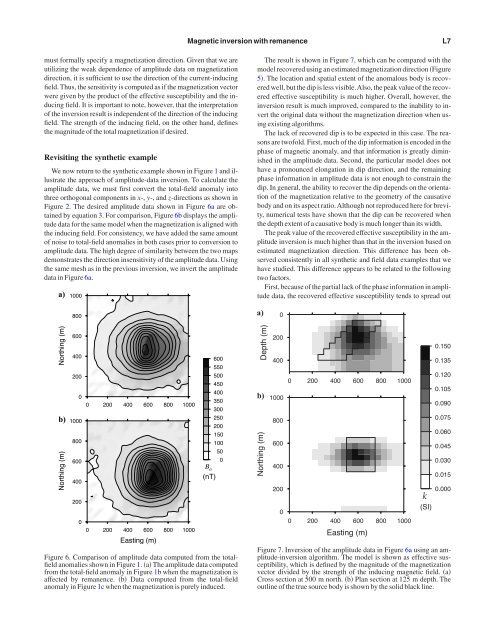Comprehensive approaches to 3D inversion of magnetic ... - CGISS
Comprehensive approaches to 3D inversion of magnetic ... - CGISS
Comprehensive approaches to 3D inversion of magnetic ... - CGISS
You also want an ePaper? Increase the reach of your titles
YUMPU automatically turns print PDFs into web optimized ePapers that Google loves.
Magnetic <strong>inversion</strong> with remanence<br />
L7<br />
must formally specify a magnetization direction. Given that we are<br />
utilizing the weak dependence <strong>of</strong> amplitude data on magnetization<br />
direction, it is sufficient <strong>to</strong> use the direction <strong>of</strong> the current-inducing<br />
field. Thus, the sensitivity is computed as if the magnetization vec<strong>to</strong>r<br />
were given by the product <strong>of</strong> the effective susceptibility and the inducing<br />
field. It is important <strong>to</strong> note, however, that the interpretation<br />
<strong>of</strong> the <strong>inversion</strong> result is independent <strong>of</strong> the direction <strong>of</strong> the inducing<br />
field. The strength <strong>of</strong> the inducing field, on the other hand, defines<br />
the magnitude <strong>of</strong> the <strong>to</strong>tal magnetization if desired.<br />
Revisiting the synthetic example<br />
We now return <strong>to</strong> the synthetic example shown in Figure 1 and illustrate<br />
the approach <strong>of</strong> amplitude-data <strong>inversion</strong>. To calculate the<br />
amplitude data, we must first convert the <strong>to</strong>tal-field anomaly in<strong>to</strong><br />
three orthogonal components in x-, y-, and z-directions as shown in<br />
Figure 2. The desired amplitude data shown in Figure 6a are obtained<br />
by equation 3. For comparison, Figure 6b displays the amplitude<br />
data for the same model when the magnetization is aligned with<br />
the inducing field. For consistency, we have added the same amount<br />
<strong>of</strong> noise <strong>to</strong> <strong>to</strong>tal-field anomalies in both cases prior <strong>to</strong> conversion <strong>to</strong><br />
amplitude data. The high degree <strong>of</strong> similarity between the two maps<br />
demonstrates the direction insensitivity <strong>of</strong> the amplitude data. Using<br />
the same mesh as in the previous <strong>inversion</strong>, we invert the amplitude<br />
data in Figure 6a.<br />
a)<br />
1000<br />
The result is shown in Figure 7, which can be compared with the<br />
model recovered using an estimated magnetization direction Figure<br />
5. The location and spatial extent <strong>of</strong> the anomalous body is recovered<br />
well, but the dip is less visible.Also, the peak value <strong>of</strong> the recovered<br />
effective susceptibility is much higher. Overall, however, the<br />
<strong>inversion</strong> result is much improved, compared <strong>to</strong> the inability <strong>to</strong> invert<br />
the original data without the magnetization direction when using<br />
existing algorithms.<br />
The lack <strong>of</strong> recovered dip is <strong>to</strong> be expected in this case. The reasons<br />
are tw<strong>of</strong>old. First, much <strong>of</strong> the dip information is encoded in the<br />
phase <strong>of</strong> <strong>magnetic</strong> anomaly, and that information is greatly diminished<br />
in the amplitude data. Second, the particular model does not<br />
have a pronounced elongation in dip direction, and the remaining<br />
phase information in amplitude data is not enough <strong>to</strong> constrain the<br />
dip. In general, the ability <strong>to</strong> recover the dip depends on the orientation<br />
<strong>of</strong> the magnetization relative <strong>to</strong> the geometry <strong>of</strong> the causative<br />
body and on its aspect ratio.Although not reproduced here for brevity,<br />
numerical tests have shown that the dip can be recovered when<br />
the depth extent <strong>of</strong> a causative body is much longer than its width.<br />
The peak value <strong>of</strong> the recovered effective susceptibility in the amplitude<br />
<strong>inversion</strong> is much higher than that in the <strong>inversion</strong> based on<br />
estimated magnetization direction. This difference has been observed<br />
consistently in all synthetic and field data examples that we<br />
have studied. This difference appears <strong>to</strong> be related <strong>to</strong> the following<br />
two fac<strong>to</strong>rs.<br />
First, because <strong>of</strong> the partial lack <strong>of</strong> the phase information in amplitude<br />
data, the recovered effective susceptibility tends <strong>to</strong> spread out<br />
800<br />
a)<br />
0<br />
Northing (m)<br />
b)<br />
Northing (m)<br />
600<br />
400<br />
200<br />
0<br />
1000<br />
800<br />
600<br />
400<br />
200<br />
0<br />
0 200 400 600 800 1000<br />
0 200 400 600 800 1000<br />
Easting (m)<br />
B a<br />
(nT)<br />
Figure 6. Comparison <strong>of</strong> amplitude data computed from the <strong>to</strong>talfield<br />
anomalies shown in Figure 1. a The amplitude data computed<br />
from the <strong>to</strong>tal-field anomaly in Figure 1b when the magnetization is<br />
affected by remanence. b Data computed from the <strong>to</strong>tal-field<br />
anomaly in Figure 1c when the magnetization is purely induced.<br />
600<br />
550<br />
500<br />
450<br />
400<br />
350<br />
300<br />
250<br />
200<br />
150<br />
100<br />
50<br />
0<br />
Depth (m)<br />
b)<br />
Northing (m)<br />
200<br />
400<br />
1000<br />
800<br />
600<br />
400<br />
200<br />
0<br />
0 200 400 600 800 1000<br />
0 200 400 600 800 1000<br />
Easting (m)<br />
k<br />
(SI)<br />
0.150<br />
0.135<br />
0.120<br />
0.105<br />
0.090<br />
0.075<br />
0.060<br />
0.045<br />
0.030<br />
0.015<br />
0.000<br />
Figure 7. Inversion <strong>of</strong> the amplitude data in Figure 6a using an amplitude-<strong>inversion</strong><br />
algorithm. The model is shown as effective susceptibility,<br />
which is defined by the magnitude <strong>of</strong> the magnetization<br />
vec<strong>to</strong>r divided by the strength <strong>of</strong> the inducing <strong>magnetic</strong> field. a<br />
Cross section at 500 m north. b Plan section at 125 m depth. The<br />
outline <strong>of</strong> the true source body is shown by the solid black line.
















